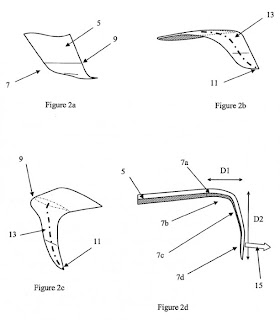Aircraft
designers have traditionally used winglets as a means to reduce induced drag
and save on consequent fuel burn aka operating costs. Over the years several
designs have emerged and the classic end plates and winglets are common in
Boeing and airbus models. General aviation aircraft on the other hand have more
innovative designs of winglets to enhance operational cost benefits.
 While
an equivalent increase in wingspan would be more effective than a winglet of
the same length, the bending force becomes a greater factor. Typically, a three-foot winglet has the same
bending force as a one-foot increase in span, yet gives the same performance gain
as a two-foot wing span increase. For
this reason, most designers have concentrated their efforts in winglets designs
to reduce drag.
While
an equivalent increase in wingspan would be more effective than a winglet of
the same length, the bending force becomes a greater factor. Typically, a three-foot winglet has the same
bending force as a one-foot increase in span, yet gives the same performance gain
as a two-foot wing span increase. For
this reason, most designers have concentrated their efforts in winglets designs
to reduce drag.
Raked wingtips are a feature on some Boeing airliners,
where the tip of the wing has a higher degree of sweep than the rest of the
wing. This additional feature is designed to improve fuel efficiency and climb
performance, and to shorten takeoff field length. It does this in much the same
way that winglets do, by increasing the effective aspect ratio of the wing and
interrupting harmful wingtip vortices. This decreases the amount of
lift-induced drag experienced by the aircraft. In testing by Boeing and NASA,
raked wingtips have been shown to reduce drag by as much as 5.5%, as opposed to
improvements of 3.5% to 4.5% from conventional winglets.
 On the Boeing 737 MAX, a new type of wingtip device has
been introduced. Resembling a three-way hybrid between a blended winglet,
wingtip fence, and raked wingtip, Boeing claims that this new design should
deliver an additional 1.5% improvement in fuel economy over the 10-12%
improvement already expected from the 737 MAX.
On the Boeing 737 MAX, a new type of wingtip device has
been introduced. Resembling a three-way hybrid between a blended winglet,
wingtip fence, and raked wingtip, Boeing claims that this new design should
deliver an additional 1.5% improvement in fuel economy over the 10-12%
improvement already expected from the 737 MAX. Airbus has filed a patent for a downward-facing
winglet device during January this year. The new wing tip device is being
described as a wing extension that may be swept and may deform during flight.
This flexible wing tip extension provides a drag reduction whilst decreasing
the bending moment of the wing, particularly at the wing root. Aircraft
performance might benefit during both steady flight and high-lift manoeuvres. A close
look at the Boeing design of the hybrid winglets on the 737 max, show some close
resemblance to the airbus design. A patent war may be in the offing between
these two rivals to lay claim to this design.
Airbus has filed a patent for a downward-facing
winglet device during January this year. The new wing tip device is being
described as a wing extension that may be swept and may deform during flight.
This flexible wing tip extension provides a drag reduction whilst decreasing
the bending moment of the wing, particularly at the wing root. Aircraft
performance might benefit during both steady flight and high-lift manoeuvres. A close
look at the Boeing design of the hybrid winglets on the 737 max, show some close
resemblance to the airbus design. A patent war may be in the offing between
these two rivals to lay claim to this design.
Because of its flexible behaviour, the
downward-facing winglet may provide a larger span during flight in comparison
to when the aircraft is on the ground.
The downward facing wing tip device allows not to be
mounted directly at the tip of the wing, but may for example be mounted spaced
apart from the wing tip that might have mounted an additional wingtip fence or
winglet. It may be also fully blended with the wing.



No comments:
Post a Comment